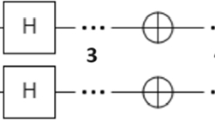Abstract
A synchronous, concerted chemical process is rigorously divided by the reaction force F(R), the negative gradient of V(R), into “reactant” and “product” regions which are dominated by structural changes and an intervening “transition” region which is electronically intensive. The reaction force constant κ(R), the second derivative of V(R), is negative throughout the transition region, not just at the nominal transition state, at which κ(R) has a minimum. This is consistent with experimental evidence that there is a transition region, not simply a specific point. We show graphically that significant nonsynchronicity in the process is associated with the development of a maximum of κ(R) in the transition region, which increases as the process becomes more nonsynchronous. (We speculate that for a nonconcerted process this maximum is actually positive.) Thus, κ(R) can serve as an indicator of the level of nonsynchronicity.

Profiles of potential energy V(R), reaction force F(R), and reaction force constant κ(R) along the intrinsic reaction coordinate R for a nonsynchronous concerted chemical reaction.







Similar content being viewed by others
References
Toro-Labbé A (1999) J Phys Chem A 103:4398–4403
Jaque P, Toro-Labbé A, Politzer P, Geerlings P (2008) Chem Phys Lett 456:135–140
Murray JS, Lane P, Göbel M, Klapötke TM, Politzer P (2009) Theor Chem Acc 124:355–363
Toro-Labbé A, Gutiérrez-Oliva S, Murray JS, Politzer P (2007) Mol Phys 105:2619–2625
Politzer P, Toro-Labbé A, Gutiérrez-Oliva S, Murray JS (2012) Adv Quantum Chem 64:189–209
Politzer P, Burda JV, Concha MC, Lane P, Murray JS (2006) J Phys Chem A 110:756–761
Kraka E, Cremer D (2010) Acc Chem Res 43:591–601
Marcus RA, Sutin N (1985) Biochim Biophys Acta 811:265–322
Politzer P, Reimers JR, Murray JS, Toro-Labbé A (2010) J Phys Chem Lett 1:2858–2862
Evans MG, Polanyi M (1938) Trans Faraday Soc 34:11–23
Dewar MJS (1984) J Am Chem Soc 106:209–219
Leffler JE (1953) Science 117:340–341
Hammond GS (1955) J Am Chem Soc 77:334–338
Nagase S, Morokuma K (1978) J Am Chem Soc 100:1666–1672
Bickelhaupt FM (1999) J Comput Chem 20:114–128
Ess DH, Houk KN (2008) J Am Chem Soc 130:10187–10198
Polanyi JC, Zewail AH (1995) Acc Chem Res 28:119–132
Zewail AH (2000) J Phys Chem A 104:5660–5694
Toro-Labbé A, Gutiérrez-Oliva S, Murray JS, Politzer P (2009) J Mol Model 15:707–710
Carey FA, Sundberg RJ (1984) Advanced organic chemistry, part A: structure and mechanisms, 2nd edn. Plenum, New York
Yepes D, Murray JS, Santos JC, Toro-Labbé A, Politzer P, Jaque P (2012) J Mol Model. doi:10.1007/s00894-012-1475-3
Yepes D, Murray JS, Politzer P, Jaque P (2012) Phys Chem Chem Phys 14:11125–11134
Labet V, Morell C, Toro-Labbé A, Grand A (2010) Phys Chem Chem Phys 12:4142–4151
Sauer J, Sustmann R (1980) Angew Chem Int Ed 19:779–807
Houk KN, González J, Li Y (1995) Acc Chem Res 28:81–90
Xu L, Doubleday CE, Houk KN (2010) J Am Chem Soc 132:3029–3037
Moyano A, Rios R (2011) Chem Rev 111:4703–4832
Acknowledgments
The authors acknowledge Fondo Nacional de Desarrollo Científico y Tecnológico de Chile (FONDECYT), grant number 1100291 through the project N° 1100291. P.J. thanks the Universidad Andres Bello for continuous support of his research group.
Author information
Authors and Affiliations
Corresponding authors
Rights and permissions
About this article
Cite this article
Politzer, P., Murray, J.S. & Jaque, P. Perspectives on the reaction force constant. J Mol Model 19, 4111–4118 (2013). https://doi.org/10.1007/s00894-012-1713-8
Received:
Accepted:
Published:
Issue Date:
DOI: https://doi.org/10.1007/s00894-012-1713-8




